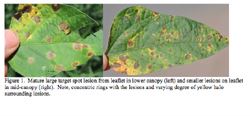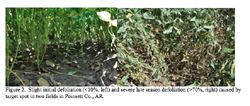|
Target Spot Of Soybean: What Do We Know?
DR. TRAVIS FASKE
LONOKE, ARK.
Historically, target spot (TS) of soybean has been a minor disease in Arkansas and the Mid-South. This disease would develop in the lower canopy with one to a few lesions per leaf with little or no further development. Since 2014, this disease has been observed more frequently and during the 2016 cropping season it was one of the most widespread and severe foliar diseases of soybean in the state. There were several reports by consultants of significant defoliation (50-80 percent) that contributed to at least 15-20 bu/A loss in yield. So, given the recent concern about TS, it is a good time to review what we know about the disease and what steps we might consider for the upcoming cropping season.
Target spot is caused by the fungal pathogen, Corynespora cassiicola. This is also the same fungus that affected the 2016 cotton crop (see earlier blog article on TS of cotton) and it will also infect sesame, tomato, cowpea, pepper, and some 300 other dicot hosts. (Note: This pathogen is NOT the same pathogen that causes target spot of grain sorghum, which is Bipolaris sorghicola). The fungus overwinters in the crop residue and soil. Symptom development begins in the lower canopy with large circular lesions (1/4 to 1/2 in. diam.) with concentric rings, hence the name target spot (Fig. 1). These lesions are often surrounded by a yellow halo (Fig. 1), but the width of the halo will vary among soybean varieties. When environmental conditions favor disease development, secondary infection can occur causing smaller leaf lesions (1/16 to 1/8 in.) that spread through the mid and upper canopy (Fig. 1). Severely infected leaves defoliate, beginning in the lower canopy (Fig. 2). Thus, to the casual observer a field may appear normal from a distance. Target spot can also cause lesions on the petioles, pods, and stems that are often reddish-brown in color. Environmental factors that favor leaf infection are prolonged conditions (5-7 days) of high relative humidity (>85 percent) or free moisture provided by light rain or heavy dew AND warm temperatures. Several days of consecutive rainfall will increase the severity of disease development. For example, seven days of consecutive rainfall in 2015 and fourteen days in 2016 in some areas of the state. Leaf symptoms are most commonly observed in mid- to late-reproductive stages of growth after canopy closure, which promotes favorable conditions for disease development. In contrast, dry conditions will suppress disease development.
Estimating the yield impact by TS has yet to be determined. In cotton, defoliation by TS does not always equate to a yield loss, and when the disease develops late the growing season (NAWF5) there is little impact on yield. In soybean, university hail simulation studies have reported that 60 percent defoliation (from the lower canopy) at R3 or R5 stages of growth contributes to a 10 percent loss in yield, while 60 percent defoliation at R6 contributed to less than 5 percent loss in yield. Though hail studies are not a perfect comparison to a disease, especially one like TS that produces a toxin, it does provide some basis for determining yield losses. During the 2016 cropping season, TS was not the only disease or contributing factor for yield loss, but it seem to have been an important issue, at least in a few fields.
There is need for applied research to better understand how to manage this disease; however, based on what is known about other foliar diseases and what was observed last year some basic principles of disease management can be adapted. Variety selection is important as some varieties were more susceptible to TS than others, therefore, soybean varieties that were observed to be susceptible to TS should be avoided in fields with a history of TS. Some of the more susceptible varieties observed in 2016 consisted of Armor 47R13, Asgrow 4632, Credenz CZ 5150, Stine 47LF32 and Dyna Gro 48RS53 (cross ref.: Delta Grow DG 4765GENRR2Y, MorSoy R247X12, Mycogen 5N479R2, Progeny P4850RYS, and Croplan R2C4752S), just to name a few. Cultural practices that consist of rotation with corn, grain sorghum or rice will reduce the amount of inoculum for the subsequent crop. Because the pathogen overwinters in crop debris and in the soil (2 yrs), producers should take into consideration this disease may be more problematic in fields with a history of the disease in cotton and soybean. Planting and production practices that promote a quick canopy closer may be at a higher risk for TS development, which needs to be further investigated. Though most university research trials of foliar diseases in North America have focused on frogeye leaf spot and Cercospora leaf blight, there have been some fungicide trials on TS in South America. In these trials, fluxapyroxad (an SDHI fungicide and one of the components in Priaxor) and prothioconazole (a DMI or triazole fungicide that is one of the components in Stratego YLD) fungicides have been efficient in controlling TS. Such trials are needed, but laboratory experiments are being planned this winter to determine the efficacy of these and other commonly used fungicides to suppress fungal growth from isolates collected in Arkansas. Furthermore, because TS begins in the lower canopy like sheath blight in rice, fungicide timing will be an important component in plant protection. Suppressing disease development before it has a chance to move up the canopy and utilizing enough water volume to carry the fungicide into the canopy will be important factors in managing this disease. So, scout and monitor fields near canopy closure for TS development, and if conditions are forecasted to favor disease development, a fungicide may be warranted to protect soybean yield potential. If a fungicide is used to manage TS leaving three non-treated strips in the field can be helpful to determine its impact on yield.
If you have any questions please feel contact Travis Faske at tfaske@uaex.edu. ∆
DR. TRAVIS FASKE: Extension Plant Pathologist, University of Arkansas


|
|